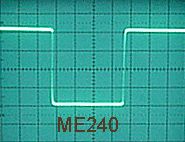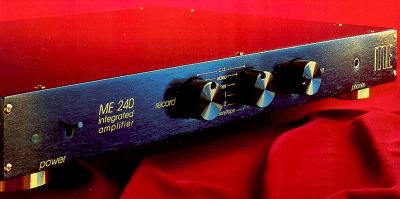Product Review - ME240 Integrated Amplifier - October, 2000
David Wurtz
![]()
|
ME 240 Integrated Amplifier Output:
2
x 90 watts RMS at 8 Ohms (DC –
20 kHz), MFR:
DC – 100 kHz � 1dB Voltage
Gain: 36 dB Max
output Voltage: 45 Volts Max
output Current: 40 Amps (peak) Input
Impedance: 50 kOhms Phase: Non-inverting,
Zero Degrees Shift THD:
Less than 0.1% Hum
and Noise: 96 dB below rated output Energy
Storage in Power Supply: 44,000�F
(Standard) 102,000�F
(High Capacitance Option) Weight: 11 Kilos (24 Pounds) MRRP:
$1895AUS (+$308 for High Capacitance Option
and+ $181 for Remote Control option) Total price as tested $2,384 AUS (About $1,400 US) |
ME
Sound, 727 Wang Wauk Road, Dyers Crossing, NSW Australia 2429; Phone: 61
(0)2 6550 2254; Fax: 61 (0)2 6550 2341 |
Introduction
ME Sound (formerly “Modular Electronics”) was formed in September, 1976 by Mr. Peter Stein, who, after many years in the electronic repair and design industries, realized that the best way to supply the customer with the ideal Hi-fi product, was to do it all himself.
He worked on two main design philosophies:
Updatability - It should be possible for previously purchased products to be upgraded to the latest hardware versions.
AND
Design
Integrity - Peter fundamentally believes an amplifier’s prime goal is to drive
loudspeakers and reproduce music in its entirety and not to necessarily perform well in laboratory
tests or to be what is fashionable at the time. The resulting technologies and design
philosophies, e.g., high current design, minimal negative feedback, minimum of 5% pure
“Class A” amplification, oversized power supplies (with ME’s energy storage
matrix which I will explain later), and the products ability to drive a minimum speaker
load of 2 ohms, have led ME Sound to be one of Australia’s leading power amplifier
producers and sellers. A lack of feedback can sometimes result in a reduced
frequency response on the test bench, and higher THD. The spec at 0.1% THD is
the result with the ME240, but as I said, Peter focuses on the sound, not the
oscilloscope.
The amp that I currently have under test is ME’s only “Integrated Amplifier”, the ME240. This is available with 2 options: the first being an upgraded power supply and the second, a remote control, both of which were supplied with this unit. ME also have a range of 3 power amplifier models (ranging up to the ME850 @ $5295), 7 preamp models, a 3 channel “Home Theatre” amplifier and finally a high quality DAC.
The
Product
For
its size, the ME240 is quite heavy and very solidly built, coming in at 11 Kgs or 23
pounds.
Initial inspection reveals a
“1 rack unit”-high chassis (on large black and gold feet) with a small
“toggle style” on/off switch and three large black anodized knobs, one
volume
control, one input selector, and one record output selector.
These knobs are backlit with a red LED giving a rather attractive look when the power is
on. 
On the back, there are six high quality gold plated inputs, a tape out, and a pre-out, as well as gold plated screw terminal left and right speaker outputs which have, as most modern amps have, banana plug support. All the terminals are solidly mounted and don’t move when attaching RCA interconnects.
Internally, the amp reveals a 250W toroidal transformer and two heatsinks down either side. Rail voltage measures 50 volts, and with a total capacitance in the power supply of 102,000 mF, a maximum energy storage of 125 Joules is available from the power supply.
Now, let’s get into that energy storage matrix.
ME's energy storage matrix is fundamentally designed around having several smaller capacitors in the power supply instead of two or four large ones. The reasons (according to the designer) behind this are simple. Due to the way they have to be built, a typical large capacitor can have several different metals between the screw terminal connectors and the actual aluminum capacitor plates. These different materials can oxidize, giving a lesser connection and therefore reducing the ability of the component to supply maximum energy to the circuit. Larger capacitors also have larger inductance values, so, by paralleling several smaller capacitors together, this unwanted high inductance value is significantly reduced.
Electrically, the amp has no fuses, relays, inductors, or circuit breakers in the signal path. This virtually eliminates transmission losses. The audio output transistors are connected directly to the speaker terminals.
The 240 also has a sophisticated protection system which actually disables the power to the unit when there is a problem. This activates when either a high frequency oscillation occurs, a DC voltage is applied to the inputs, or an operating temperature of 80� C is exceeded.
This protection system does not allow the amplifier to be turned on at the power point while the power switch is on. This is part of the “protection system latching circuit” and requires a 5 second delay before the amp will switch on when it is connected to the mains (wall AC).
 The amp has built-in
intelligence. It is capable of measuring the temperature of the transistor outputs, and
then feeds that into a circuit that makes small adjustments to the fan speed to keep them
at an even operating temperature. It also samples the output signal to make sure it is
suitable for the loudspeakers it is driving. If a dangerous condition exists, the amp
shuts down, thus protecting the speakers. On the left is the +/- 10Volt output
of the amp @ 10kHz, and, as you can see, there is no overshoot or ringing. The
240's frequency response was -3dB @ 102 kHz. Both these figures are very
acceptable.
The amp has built-in
intelligence. It is capable of measuring the temperature of the transistor outputs, and
then feeds that into a circuit that makes small adjustments to the fan speed to keep them
at an even operating temperature. It also samples the output signal to make sure it is
suitable for the loudspeakers it is driving. If a dangerous condition exists, the amp
shuts down, thus protecting the speakers. On the left is the +/- 10Volt output
of the amp @ 10kHz, and, as you can see, there is no overshoot or ringing. The
240's frequency response was -3dB @ 102 kHz. Both these figures are very
acceptable.
The ME240 can be run in bridge mode, delivering
220 watts into 8 Ohms. To activate the “Bridge Mode”, an internal
adjustment must be made, but this is quite simple via an internal slide switch, which is
labeled on the main CCT board. There is also a clear and concise diagram provided, shows how to wire it all up.
The Sound
My very first impression after hooking the ME240 into my reference system (consisting of JBL 4410A Studio Monitors and Sony CDP-C545) was the transparency. The amp gave me (almost instantly) the impression that it had removed everything from my sound room except the music that I was playing. This was a very different and exciting experience, I told myself! As I wound the volume upwards, I found the transparency expanded to completely envelop me in a wonderful musical sphere. Very impressive indeed from an integrated amp! As you may know, most of the best equipment around come as separates, i.e., preamplifier and amplifier in separate chassis. ME has achieved this sound with an all-in-one unit. Dynamics were very impressive, and the stereo separation and sound stage had more than just admirable qualities. Through all my test discs I was never disappointed. Finer classical passages were perfectly articulated and focused with small sections of the orchestras being highlighted by the transparency and over all clarity.
Throughout the whole frequency range, I felt the 240 did a fine job. Bass, mids, and highs were all very clean, even, and accurate. The generally definitive test of male and female vocals was easily passed, as both where reproduced extremely accurately. Crowded House’s lead vocalist, Neil Finn, has a great set of vocal chords, and the 240 did a fantastic job of bringing him into my lounge room with such numbers as, “Don’t dream its over” and “Better be home soon”. The Red Hot Chili Peppers’ album, “Blood Sugar Sex Magic” has examples of some of the best modern funk/rock/jazz fusion available. Of particular note was Track 2, “If You Had To Ask”, a “funky little ditty” that has a heap of little things (musically) going on in the background. Especially of note is the drummer, Chad Smith, playing grace (or ghost) notes between the main strokes on the snare that were going off like gunshots. A grace/ghost note is where the drumstick is dragged/bounced along the skin in between the 2 and the 4 snare strokes. It gives a sort of rolling/swinging action between main snare beats and is sometimes very difficult to pick out. In this case, the grace notes (and all the other little hidden “easter eggs” within the song) were reproduced very finely and articulated perfectly between the more powerful segments of guitar, bass and drums.
Conclusion
At present, the current low exchange rate into the Australian market makes
this country a very lucrative choice for buyers from the US, and indeed all around the
world to look to our shores for audio equipment. But, this is not the main reason for
audio buffs to investigate what’s available “Down Under.” Australia has
several high quality amplifiers manufacturers that are designed, produced, and sold
domestically as well as internationally. I definitely recommend that the reader visit the gold
mine of Australia’s ME Sound. You won’t be disappointed - the ME240 is
definitely one of Australia’s treasures.
- David Wurtz
-
![]()
� Copyright 2000 Secrets of Home Theater & High Fidelity
Return to Table of Contents for this Issue.


